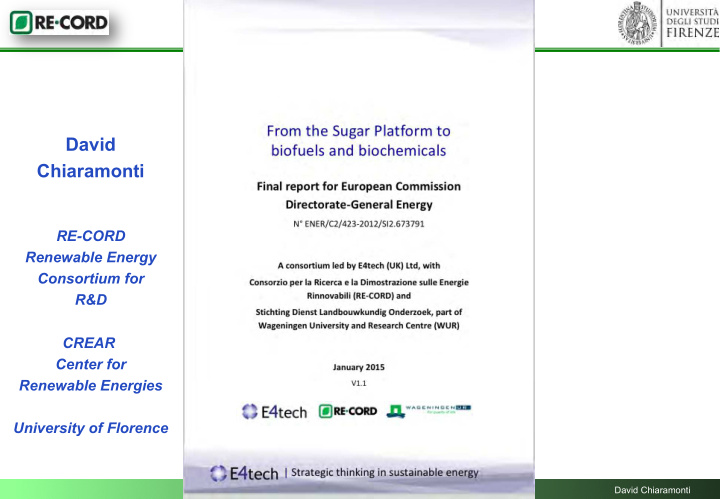



David Chiaramonti RE-CORD Renewable Energy Consortium for R&D CREAR Center for Renewable Energies University of Florence Bioenergy Italy, Cremona, Febbraio 2015 David Chiaramonti
50-100 US$ Fossil 10 US$ Bio 1 barrel = 165 liters Bioenergy Italy, Cremona, Febbraio 2015 David Chiaramonti
Bioenergy Italy, Cremona, Febbraio 2015 David Chiaramonti
USDOE – NREL/PNNL study Ø Top Value Added Chemicals from Biomass Ø Biobased Syngas and Sugars Platforms Ø Top 30 candidates that: 1) exhibited multiple functionalities suitable for further conversion as derivatives or molecular families 2) could be produced from both lignocellulosics and starch, 3) were C1-C6 monomers, 4) were not aromatics derived from lignin 5) were not already supercommodity chemicals. Bioenergy Italy, Cremona, Febbraio 2015 David Chiaramonti
USDOE – NREL/PNNL study Bioenergy Italy, Cremona, Febbraio 2015 David Chiaramonti
F EEDSTOCK Ø US • corn residue (cobs, leaves, husk and some stalk) Ø Brasil • sugar can bagasse, but also other residues and dedicated crops Ø EU • residues and wastes (straw) + no food lignocellulosic crops Ø Asia • straw/agricultural residues as major feedstock so far Bioenergy Italy, Cremona, Febbraio 2015 David Chiaramonti
The Sugar Platform to Biobased Chemicals Ø “From an energy and hydrogen balance standpoint, biochemical platforms are more efficient at producing oxidized products than highly reduced molecules . Highly oxidized products such as lactic, acetic and adipic acids command significantly higher prices than ethanol or biodiesel and they are challenging to make by non-biochemical platforms .” [..] Since sugar molecules inherently contain high amounts of oxygen, it is more efficient to convert them to oxidized intermediates and aim for higher value chemicals markets .” Ø The Heff/C Staircase: “It is apparent that fewer steps must be ‘climbed’ (or none in the case of sugar conversion to acetic or lactic acids) along the Heff/C ‘staircase’ for sugar to be converted to intermediates that, in the short term at least, can be sold as chemical precursors rather than as fuels.” Source: IEA-T39 Drop-in Biofuels report, 2013 Bioenergy Italy, Cremona, Febbraio 2015 David Chiaramonti
Biomass Chain: Revenue Potential There are significant revenue potentials along the entire biomass value chain. The values given are approximate business potential in US$ billions by 2020 [ Source: D.King. The Future of Industrial Biorefineries. WEF. 2010] Bioenergy Italy, Cremona, Febbraio 2015 David Chiaramonti
EU competitiveness Ø Lots of EU R&D Ø Demonstration / implementation in US, China, Brazil. Bioenergy Italy, Cremona, Febbraio 2015 David Chiaramonti
EU competitiveness vs Market Expansion Ø Most expansion in …not only biofuels…also bioproducts going the same way.. capacity expected outside the EU, in Asia and South America Ø Which are the main factors for that? ð Policy (ILUC-post 2020)? ð Innovation-related policies? ð Biomass availability/cost? EU: Impact of Policy and Economic Crisis ð Structure/size of farms & ü NER3001: 300 M € unused awards by UPM- Logistics? Stracel, Westwave, Pyrogrot and Ajos BTL ð Financing? ü Other 250-450 M € awards at risk ð Sustainability certification? ü UPM statement: [..] uncertainty in the regulatory ð Demand-side management? outlook for advanced biofuels [..] Bioenergy Italy, Cremona, Febbraio 2015 David Chiaramonti
Chemicals – Vision 2030 (Source: ATKearney) The core of the chemical industry is shifting to Asia, and by 2030 at least Bioproducts fits into a half of the top 10 chemical companies will be Asian or Middle Eastern wider scenario .. Sales ( € billion; 2030 is calculated at 2010 prices and exchange rates) 480 2 , 353 4 , 637 Asia 15 % Europe 49 % Chemicals production in Europe is expected to grow moderately, with slightly NAFTA higher demand for consumer chemicals 66 % 45 % Rest of world Production volumes 25 % ( € billion, 2010 prices) 15 % 30 % 19 % Ruler strategy 1 12 % 587 578 87 0 . 9 % 10 % 7 % 7 % Organic chemicals 2 1985 1 2010 2030 e 2 491 Polymers 300 ( 51 %) Consumer chemicals 1 . 1 % Basic inorganics 244 ( 50 %) CAGR 118 ( 20 %) 0 % 118 ( 24 %) 105 ( 18 %) 63 ( 13 %) 2 . 6 % 67 ( 14 %) – 0 . 2 % 64 ( 11 %) 2010 Europe 2010 Europe 2010 2030 e excluding EU 27 EU 27 EU 27 Note: EU 27 refers to the 27 member states of the European Union. 1 Ruler strategy production volume CAGR 2000 - 10 extrapolated to 2030 ; 0 . 9 % is expected ruler strategy CAGR for EU 27 2010 - 2030 . Value and weighting re f lect 2010 prices. 2 Petrochemicals and specialty chemicals are included in the category “organic chemicals.” Sources: European Chemical Industry Council (CEFIC); A.T. Kearney analysis Bioenergy Italy, Cremona, Febbraio 2015 David Chiaramonti
Commercialising Bioproducts = Bring Innovation to Market Demand as barrier to Innovation – Policy measures [Source: J.Elder. Review of Policy Measures to Stimulate Private Demand for Innovation. Concepts and Effects. NESTA Working Paper N0. 13/13. 2013] Bioenergy Italy, Cremona, Febbraio 2015 David Chiaramonti
Impact of policies on bio products market Ø Example: plastic/biodegradable bags Ø European Union’s decided to reduce overall consumption of thin plastic bags in the region by about 80% by 2019, compared to 2010 consumption levels. Ø The biodegradable plastics market in Europe is forecast to witness a robust CAGR (Compound Annual Growth Rate) of around 12% during 2014-19 Bioenergy Italy, Cremona, Febbraio 2015 David Chiaramonti
Thanks for your attention David Chiaramont i RE-CORD , Renewable Energy COnsortium for R&D CREAR , Research Center for Renewable Energy, University of Florence david.chiaramonti@re-cord.org - david.chiaramonti@unifi.it Bioenergy Italy, Cremona, Febbraio 2015 David Chiaramonti
Recommend
More recommend